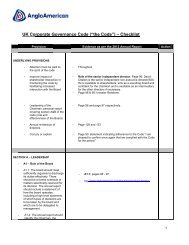Download PDF - Kumba Iron Ore
Download PDF - Kumba Iron Ore
Download PDF - Kumba Iron Ore
Create successful ePaper yourself
Turn your PDF publications into a flip-book with our unique Google optimized e-Paper software.
The group’s criteria for a derivative instrument to be designated as a<br />
hedging instrument require that:<br />
<br />
effective in achieving offsetting changes in fair value or cash flows<br />
attributable to the hedged risk;<br />
<br />
throughout the duration of the hedge;<br />
<br />
of the hedge; and<br />
<br />
of the hedge is highly probable.<br />
A derivative instrument is classified as a cash flow hedge<br />
when it is designated and qualifies as hedge of a particular risk<br />
associated with a recognised asset or liability or highly probable<br />
forecasted transaction.<br />
The effective portion of any fair value gain or loss arising on such<br />
a derivative instrument is classified in comprehensive income as a<br />
cash flow hedge accounting reserve until the underlying transaction<br />
occurs. The ineffective part of any gain or loss is recognised<br />
immediately in the income statement within ‘finance gains/(losses)’.<br />
If the forecasted transaction results in the recognition of a nonfinancial<br />
asset or non-financial liability, the associated gain or loss<br />
is transferred from the cash flow hedge accounting reserve and<br />
included in the initial measurement of the cost of the underlying<br />
asset or liability on the transaction date. For hedges that do not<br />
result in the recognition of a non-financial asset or liability, amounts<br />
deferred in equity are recognised in the income statement in the<br />
same period in which the hedged item affects profits or loss.<br />
Hedge accounting is discontinued when the hedging instrument<br />
expires or is sold, terminated, exercised, revoked, or no longer<br />
qualifies for hedge accounting. At that time, any cumulative gain or<br />
loss on the hedging instrument recognised in equity is retained in<br />
equity until the forecast transaction occurs. If a hedge transaction<br />
is no longer expected to occur, the net cumulative gain or loss<br />
previously recognised in equity is included in the income statement<br />
within ‘finance gains/(losses)’ for the period.<br />
OFFSET<br />
Where a legally enforceable right of offset exists for recognised<br />
financial assets and financial liabilities, and there is an intention to<br />
settle the liability and realise the asset simultaneously, or to settle on<br />
a net basis, all related financial effects are offset and the net amount<br />
is reported in the balance sheet.<br />
4.7 Inventories<br />
Inventories, which comprise finished products, work-in-progress,<br />
plant spares and stores, raw material and merchandise, are<br />
measured at the lower of cost, determined on a weighted average<br />
basis, and net realisable value.<br />
The cost of finished goods and work-in-progress comprises raw<br />
materials, direct labour, other direct costs and fixed production<br />
overheads, but excludes finance costs. Fixed production overheads<br />
are allocated on the basis of normal capacity.<br />
Plant spares and consumable stores are capitalised to the balance<br />
sheet and expensed to the income statement as they are utilised.<br />
Net realisable value is the estimated selling price in the ordinary<br />
course of business, less the cost of completion and selling expenses.<br />
Write-downs to net realisable value and inventory losses are<br />
expensed in the income statement in the period in which the writedowns<br />
or losses occur.<br />
4.8 Share capital<br />
Ordinary shares are classified as equity instruments.<br />
Incremental costs directly attributable to the issue of new shares are<br />
shown in equity as a deduction there from, net of tax. Incremental<br />
costs directly attributable to the issue of new shares for the<br />
acquisition of a business are included in the cost of acquisition as<br />
part of the purchase consideration.<br />
4.9 Treasury shares<br />
When the group acquires its own share capital, the amount of the<br />
consideration paid, including directly attributable costs, net of any<br />
related tax benefit, is recognised as a change in equity. Shares<br />
repurchased by the issuing entity are cancelled.<br />
Shares repurchased by group entities are classified as treasury<br />
shares and are held at cost. These shares are treated as a deduction<br />
from the issued and weighted average number of shares, and the<br />
cost price of the shares is presented as a deduction from total<br />
equity. The par value of the shares is presented as a deduction from<br />
ordinary share capital and the remainder of the cost is presented<br />
as a deduction from ordinary share premium. Dividends received on<br />
treasury shares are eliminated on consolidation.<br />
4.10 Dividends payable<br />
Dividends payable and the related taxation thereon are recognised<br />
by the group when the dividend is declared. These dividends are<br />
recorded and disclosed as dividends in the statement of changes<br />
in equity. Secondary Taxation on Companies (STC) in respect of<br />
such dividends is recognised as a liability when the dividends are<br />
recognised as a liability and are included in the taxation charge in<br />
profit or loss.<br />
Dividends proposed or declared subsequent to the balance sheet<br />
date are not recognised, but are disclosed in the notes to the<br />
consolidated financial statements.<br />
4.11 Provisions<br />
Provisions are recognised when the group has a present legal or<br />
constructive obligation as a result of past events, for which it is<br />
probable that an outflow of economic benefits will be required to<br />
settle the obligation, and a reliable estimate can be made of the<br />
amount of the obligation. Provisions are not recognised for future<br />
operating losses.<br />
ENVIRONMENTAL REHABILITATION<br />
Environmental rehabilitation provisions<br />
The provision for environmental rehabilitation is recognised as and<br />
when an obligation to incur rehabilitation and mine closure costs<br />
arises from environmental disturbance caused by the development<br />
or ongoing production of a mining property. Estimated long-term<br />
environmental rehabilitation provisions are measured based on<br />
the group’s environmental policy taking into account current<br />
technological, environmental and regulatory requirements. Any<br />
subsequent changes to the carrying amount of the provision<br />
resulting from changes to the assumptions applied in estimating the<br />
obligation are recognised in the income statement.<br />
Audited annual financial statements<br />
Annual Financial Statements 2011<br />
33



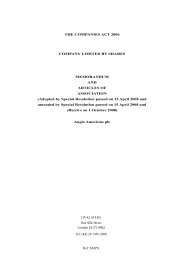
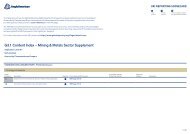
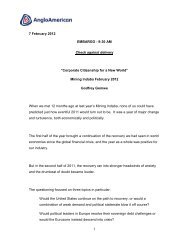
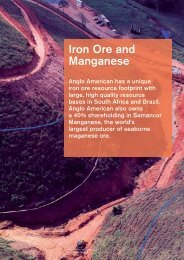
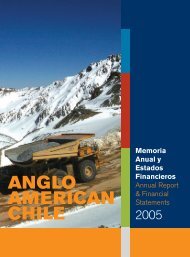
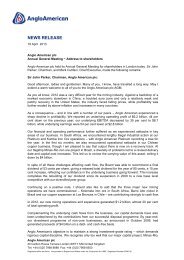
![English PDF [ 189KB ] - Anglo American](https://img.yumpu.com/50470814/1/184x260/english-pdf-189kb-anglo-american.jpg?quality=85)


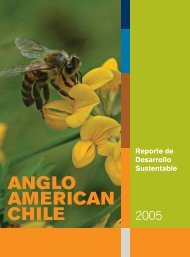

![pdf [ 595KB ] - Anglo American](https://img.yumpu.com/49420483/1/184x260/pdf-595kb-anglo-american.jpg?quality=85)
![pdf [ 1.1MB ] - Anglo American](https://img.yumpu.com/49057963/1/190x240/pdf-11mb-anglo-american.jpg?quality=85)
